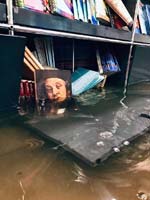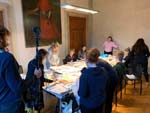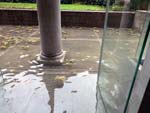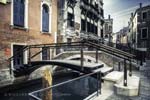
|

|
|
Home Site Search Contact Us Subscribe
|
|
Scarpa and Botta Interventions Severely Damaged in Venice Floods Fondazione Querini Stampalia initiates fundraising for restoration of its architectural and cultural treasures. By JoAnn Locktov December 12, 2019 On November 12, Venice experienced the perfect storm. The normal acqua alta (high tide) that Venetians have lived with for the duration of their 1,600-year existence was propelled by 100kmh (62mph) winds coming from three directions. The lagoon ‘s morphology is now so compromised from dredging and the installation of flood barriers (a painful irony) that just before midnight water flooded Venice with such a force that boats sank, newsstands were blown into canals, windows were shattered, gondolas were swept onto embankments, and practically every ground floor in the entire city was flooded. The prior flood to wreak this kind of damage was in 1966, when waters reached 194cm (6ft). This night was different because of the speed and the force of the water. The four blasts of the high tide warning system alerted Venetians to what was coming, but no one was prepared for the fierce deluge that turned Via Garibaldi into a raging river, Piazza San Marco into a swimmable lake, and the disappearance of borders between pavement and canal.
Along with residences, businesses, churches, museums, and the basilica, Fondazione Querini Stampalia in Campo Santa Maria Formosa suffered extensive damage. Count Giovanni, the last descendent of the Querini Stampalia family, bequeathed the 16th-century palazzo to Venice. In 1869, the palazzo became the home of the Querini Stampalia Foundation. Many a scholar, student, writer, and architect has utilized the library, open until midnight and on holidays – a stipulation made by the Count. On subsequent floors are furnishings from the 18th and 19th centuries, and paintings that offer a voyage through the history of art, from the Renaissance of Giovanni Bellini to the 18th century works of Giambattista Tiepolo, Pietro Longhi, and Gabriel Bella.
Venice is a city born of a lagoon. The residents take precautions to mitigate water damage. At Querini Stampalia, the ground floor exhibition areas and garden were restored by Carlo Scarpa in the 1960s, and the new entrance, bookshop, café, and auditorium by Mario Botta in the 1990s, so that the space could absorb a flood height of 160cm (5ft). But on November 12, the waters reached 187cm (6ft) – the damage was devastating. Over 35 linear meters (115ft) of miscellanies from the 19th century needed urgent conservation and were rushed to the largest restoration laboratory in Italy, where the patient restoration experts live like Benedictine monks. Another 460 linear meters (1,509ft) of modern publications were completely submerged.
When Scarpa designed the ineffable ground floor exhibition spaces, he knew that water was as natural to Venice as the air we breathe. Rather than fight the the tides, he welcomed them with the construction of water gates and moats to integrate the aqueous elements. Valeriano Pastor (the architect who intervened on a part of the building in the 1980s) wrote in Dream of Venice Architecture: “Scarpa goes straight to the heart of it, exalting the poetry inherent in the natural phenomenon while befriending its aggressive action. It is a metonymic model – wonderful in itself – of the Venice Lagoon system. His hope, in the transition to a larger scale, was that it would be grasped in its conceptual beauty. This, too, invites a choral meditation on other serious environmental changes. Will we understand the meaning of it?”
Scarpa knew. But with the meteorological and man-made crises in the lagoon, not even his prescient design could contain the raging waters of November 12. Insidious salt, sewage, and submersion have damaged the entire area. Fondazione Querini Stampalia estimates that it will cost more than $500,000 to restore Scarpa’s legacy, the library, bookshop, elevators, and the Botta interventions.
Marigusta Lazzari, the director of the foundation, reflects on the damage: “Over the past 30 years, considerable resources have been invested in restoration works that have secured the building structure from high tides up to a level of 160cm (5ft). Our daily commitment and attention to cost efficiency have been thwarted by this dramatic event, and it is with great sadness that we must assert that this will heavily affect the foundation in the near future.”
The foundation has set up a fund to help with its recovery efforts. Please consider donating. Querini Stampalia is one of the remarkable architectural treasures of Venice, and deserves our support.
JoAnn Locktov is the publisher of the Dream of Venice trilogy, including Dream of Venice Architecture. A portion of the proceeds from every book sold is donated to Fondazione Querini Stampalia. See Saxon Henry’s “Raw Elegance in Black and White: Q&A with JoAnn Locktov” on ArchNewsNow.com, an interview about the final book in the trilogy, Dream of Venice in Black and White.
Donations:
U.S. citizens:
Canadian citizens: https://www.kbfcanada.ca/en/projects/preserving-a-venetian-heritage-2/
International: http://www.querinistampalia.org/eng/support_us/venice_flooding_12_november_2019.php
Fondazione Querini Stampalia: more information http://www.querinistampalia.org/eng/home_page.php
Dream of Venice Architecture: http://bellafigurapublications.com/dream-venice-architecture/ |
(click on pictures to enlarge)  Fondazione Querini Stampalia Fondazione Querini Stampalia - water, water everywhere  Fondazione Querini Stampalia Assessing the damage  Fondazione Querini Stampalia04 Drying treasures  Fondazione Querini Stampalia The water recedes  Riccardo de Cal - "Dream of Venice Architecture" (www.riccardodecal.com) The Carlo Scarpa-designed ladder stairs, watergate, and moat, which acts as an internal canal to absorb the waters during acqua alta (high tide).  Riccardo de Cal - "Dream of Venice Architecture" The new entrance bridge for the Fondazione Querini Stampalia by Carlo Scarpa: The City of Venice was unwilling to give him a permit for such a modern structure, so he had it built at night.  Riccardo de Cal - "Dream of Venice Architecture" Hortus Conclusus, the small enclosed garden designed by Carlo Scarpa.  Riccardo de Cal - "Dream of Venice Architecture" A detail of the 24k gold glass mosaic tiles in the garden, designed by Carlo Scarpa and created by Mosaici Dona’ Murano. |
© 2019 ArchNewsNow.com